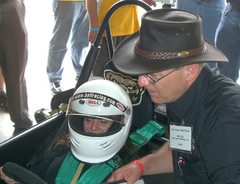The first major event of the FSAE/FS season has passed with Oregon State/GFR winning the FSAE event at Michigan International Speedway a couple of weeks ago.
From my perspective the Michigan event was the best ever. This was mainly down to the efforts of our own Steve Fox who holds the position of Joint Design Captain there. Steve introduced many of our FSG practices, especially Rookie Design Judges and Design Judge Training, something we have done at Hockenheim since the very first event, as well as compulsory Design Feedback to every team.
One surprise for teams in Design was the introduction of a 5th Percentile female ergo judge. The rules require cars to accept 95th percentile male and 5th percentile females, but most teams forget about the ladies! Be warned, this could happen again!
It was heartening to see every one of the FSG native teams who visited Michigan made it to the Design Semi Finals. This does not just show the quality of the European teams, but also that the teams have a good understanding of what they have achieved. Congratulations to all.
Testing
With only two months to go before FSG 2011, teams now enter the most dangerous phase of the event. The Pre-Event Testing phase! That is when accidents happen and with team members being tired and stressed, cars unfinished and shortcuts in safety taken, accidents happen!
Almost all teams I have talked with tell me they have experienced some kind of impact, collision or fire during testing. Testing your new car is one of the most dangerous practices you can undertake! You must be responsible and think ahead!
I have ‘discovered’ that quite a few teams do not follow good safety procedures while testing their FS cars on campus, prior to the competition. I have seen very few teams which I would rate as having exemplary test session safety procedures!
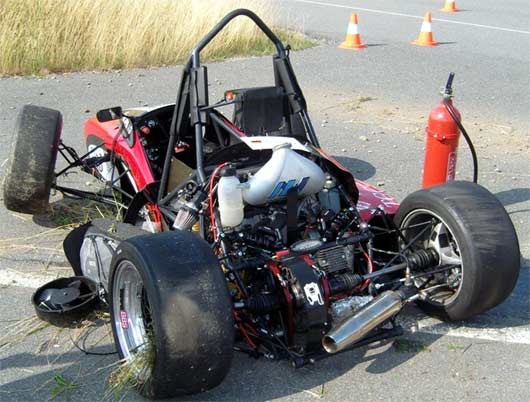
Here is a quick list of some of the things I have found:
Parking lots:
- Fixed object obstructions, to include, but certainly not limited to:
- Kerbs
- Light poles
- Parked cars
- Parking barriers
- Pedestrians
- Inadequate run-off area (needed in case of emergency)
Hazardous terrain just outside of the parking lot test area, which the car could get into if brakes/throttle failed:
- More fixed objects
- Fences
- Valleys
- Holes big enough to swallow a car (or flip it over)
- Buildings
- Water deep enough (1/2 meter or more) to drown in

Fire:
No fire extinguisher(s) present during testing.
No training on the proper use of said missing fire extinguishers.
Inadequate safety procedures involving storage of fuel at the test site. Improperly dressed personnel designated to operate fire extinguisher(s). Open toed shoes, short pants, nylon t-shirts, etc.

Driver safety apparel:
Half the teams I have spoken to have drivers missing one or more pieces of safety apparel while operating the car during a test session.
They almost always wear the gloves (by my reasoning, it is either a ‘cool factor’, or they feel that they get more control of the steering wheel with the use of gloves. Perhaps both.)
Quite a few teams including some of the bigger, better FSAE teams do not wear a fire suit while testing.
If a team has drivers wearing suits, a lot of those drivers will not go to the trouble of putting on driving shoes.
The overwhelming majority of teams do not wear fire resistant undergarments.
Wrist restraints are woefully under used and probably one of the least understood pieces of safety apparel.
Most students have wrist restraints adjusted way too loose, allowing the arm or wrist to get outside the roll over cage.
Most testers do wear a helmet, however we have certainly seen you-tube videos to the contrary (especially the infamous Thai impact test)!
What should you do regarding proper safety procedures when it is time to ‘kick the tyres & light the fires’?
Wear your safety apparel. No exceptions! Fire resistant underwear, a two layer suit, shoes, gloves, balaclava, helmet, and wrist restraints.
Head to toe coverage! No exceptions!
Do a 'blindfold test' for every driver you intend to put in the car. The driver sitting in the car blindfolded must be able to find all controls and safety gear by feel.
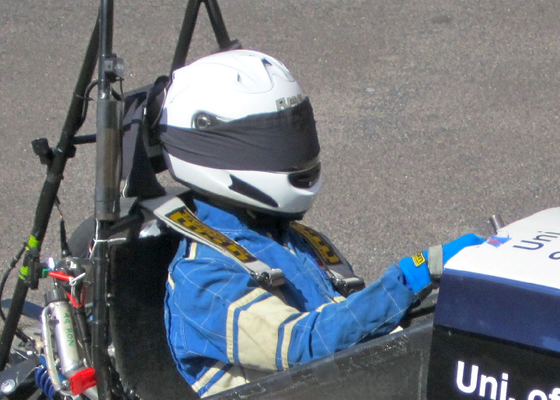
Anyone who drives the car for any reason must be able to pass the blindfold test! This means that any and all potential drivers will need ample cockpit time to get familiar with the control layout of the car. You need to allow time for this critical safety procedure before you are at the test track! The drivers must know the car’s control layout like the back of their hand.
A thought to consider:
Are your drivers left handed or right handed? A right handed driver will instinctively reach for the emergency stop switch with one hand or the other. (The dominant hand might maintain control of the steering wheel, or it might go for the switch. It all depends on what training the driver has had.) The left handed driver might go for the emergency stop switch with the opposite hand. Consider installing two e-stop switches, one on either side of the steering wheel. That way, in the heat of the moment, you have given him twice as good a chance of shutting off the car in an emergency.
Create an emergency mental checklist for the driver. Have the driver memorize this mental checklist, then practice the checklist, so that when the time comes the driver instinctively takes the correct action.
The driver emergency checklist should be:
- Hit the e-stop switch. The driver knows exactly where the e-stop is, correct?
- Control the car. (Drive it in a safe direction away from fixed objects). No matter what the emergency is, your priority is to miss the big immovable objects which will cause you the most harm!
- Bring the car to a stop, by doing the following in order:
- Use the brakes. In the case of a brake system failure…
- Down shift to a lower gear (be prepared for rear wheel lock-up, though, and the potential for spin as a result.) Scrub off speed by making a series of sharp turns left and right.
- When the car comes to a stop:
- Remove the steering wheel.
- Release the driver safety harness.
- Egress. You CAN egress in 5 seconds or less, right?
Things the team should be doing while the car is on-track, testing:
Test area selection
- Find a safe area to test which allows plenty of run-off area in case of emergency. The best test areas have no light poles, barricades, or immovable objects.
- The most obvious step (but still overlooked all too often) is to clear the parking lot! No cars allowed in the test area while you are testing (either parked or moving).
- Clear all pedestrians. If a pedestrian or bike rider invades your test area, ensure that the driver is briefed to immediately stop the car until the hazard has been cleared.
- Other team members should be positioned around the perimeter of the test area to ensure no cars, pedestrians or bikes inadvertently invade your test area.
- The team members positioned around the perimeter also have the added responsibility of watching the car closely for any signs of fire.
Fire
Fire is the biggest emergency you may have to deal with. It is the most life threatening and the one emergency you will face which needs immediate attention. Because we design and build rear engine cars, the driver is usually the last person to know they are on fire!
Therefore, it is critical that the team members positioned at the perimeter of the track are always watching the car for any sign of fire.
These team members are positioned all around the track so that no matter what direction the car is pointed, the driver always has at least one team member in his line of sight.
You need to have an agreed to signal which indicates to the driver he/she is on fire.
The driver then immediately performs the emergency procedure they are trained in (emergency-stop button, control the car, stop the car, egress)
A good team will practice ‘fire drills’ where one of the team members gives the driver the ‘Fire’ signal, at which point the driver takes appropriate action.
A team should have several team members positioned around the test track with fire extinguishers (designated fire response personnel).
The fire response team members holding the fire extinguishers should be trained in their proper use.
The fire response team members are dressed responsibly. (Long pants, long sleeve shirt, socks and good athletic shoes they can run in).
They should be wearing fire resistant (drivers) gloves and none of their clothing is flammable or made of materials which end in ‘on’. Nylon, Rayon, Orlon (polyester), etc. are all materials which melt to your skin when exposed to open flame. These materials will compound any fire related injuries!
A good fire response person will also be prepared to get the driver out of the car in an emergency.
- Is the designated fire response person prepared to do this?
- Are they physically able to?
- Are they mentally able to?
Caring for your drivers (and team members) wellbeing:
If it is hot out when you are testing your car there are additional considerations you must take into effect:
- Make sure your driver(s) have adequate protection from the sun in order to prevent heat stroke. An umbrella serves well here. A quick canopy is also worth while taking the time to set up. If you have trees with shade near your test site, make use of the natural shade.
- You will need to keep your driver hydrated. It is well established that driving a car competitively demands the same level of physical exertion as most professional athletes. Ensure that you have a good supply of water for not only the drivers, but the rest of the team members as well.
- Ensure that the drivers are well rested, well nourished, and mentally sharp.
- Have a First-Aid kit with you at the test session.
- Can you deal with minor cuts and scrapes easily, without having to abort the test session?
- Do you have any team members who are First Responders? Who know First-Aid?
- Keeping your drivers and team members healthy maximizes your test session results.
Drivers Responsibilities:
- As a good driver you owe it to your team to not be out drinking late the night before a critical test session. You should not be driving with a hangover.
- You should not be driving when you are hungry, or too full, right after eating. Your body is a machine you are trying to extract peak performance from just like the car you are testing. Treat it responsibly in order to extract peak results.
Things you can do off the test track:
- Get fire extinguisher training. This is usually available at your local fire department for little or no charge… All you have to do is make the phone call and ask for training.
- Plan each test session. Make sure everyone on the team understands the plan. Make sure every team member understands their individual role in the test session.
Almost all teams have experienced some kind of fire during testing.
Almost all teams admit to experiencing some kind of impact or collision mishap while testing.
Testing your new car is one of the most dangerous exercises you can undertake! Be responsible! Think ahead!
The old saying ‘Hope for the best, but plan for the worst’ is the best way to go about safely conducting your own testing program.
Pat’s Design Error of the Month
I saw many ‘Design Errors’ at Michigan, but I will bring a couple of them to your attention here.
Firstly, remember my Column on ‘Murphy’s Law’ and the post event presentation by Steve Fox and I on the same subject? Well, here is a classic example of ‘Murphy’s Law’!
This car had a beautifully made wiring harness, but see how at least eight of the connectors are identical? One can guarantee that at some stage in the heat of the competition, the wrong wire will be plugged in!
This wiring harness does not comply with Murphy’s Law.
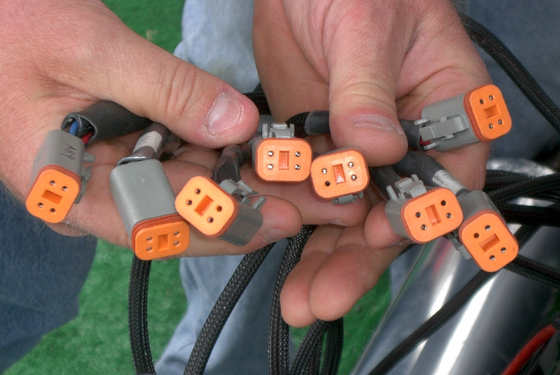
In another column, I warned about the dangers of using ‘hardware store quality’ components. This team demonstrated the reason why you should use quality hose clamps, suitable for the application. See how the slotted band has damaged the hose.
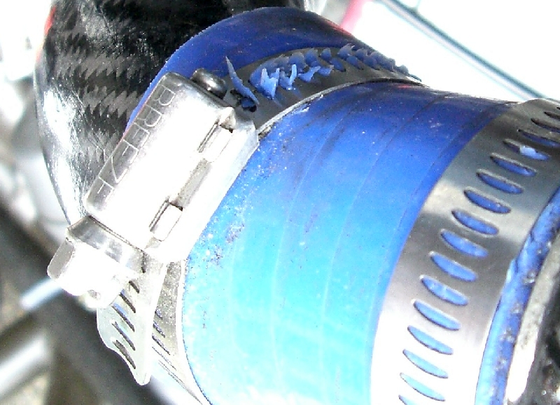
Well, that’s enough for this time. The longest Column ever, I think.
Until next time
Keep safe


